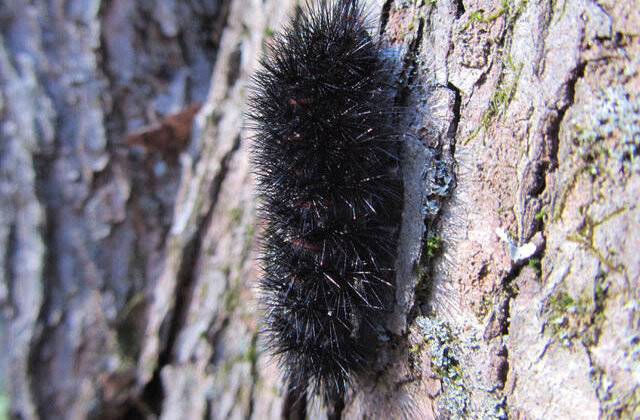The Hidden Life in Trees
Text by Susannah Wood
Photo by Wiley Wood
The first butterfly drifting through our woods in spring is the mourning cloak, its red-brown wings dabbed with pale blue, edged in cream. It survived the long winter in a semi-dormant state filled, most likely sheltering in a hollow tree or log. If you’re lucky, you may see a polyphemus moth this spring, newly hatched from its cocoon on an oak branch. A golden-crowned kinglet, a winter resident weighing in at two pennies, depends completely on tiny inchworm caterpillars it gleans from fir or spruce branches and bark. Even chickadees, the ones darting in to feeders all winter long, rely on insects for a whopping 50 percent of their cold weather diet. The common thread here is trees, native trees.
While early-flowering trees like and willows and red maples provide important sources of nectar and pollen in early spring, that is only part of the story of how essential native trees are to a vast number of insects, and in turn, to the birds, bats and other creatures that feed on them. Virtually all native trees provide food and shelter to some insects, but recent research has revealed that a much smaller group of trees (five percent) are the real heavyweights when it comes to sustaining 70 to 75 percent of the lepidoptera, the order that includes moths and butterflies. Oaks throughout the United States are the out-and-out winners, hosts to 534 different caterpillars. Willows, wild cherries and plums, and chokecherries come in at about 455, followed by birches, poplars, and then maples, at around 285 species. That’s not to say that a tulip tree, which, by comparison, supports only a handful insects, is unimportant, just that its impact is way smaller. A ginko tree from Asia supports only about five species, a Norway maple, ten.
Native trees play many roles. Some, like fruit trees and American basswood, are important food sources for pollinators because they produce a mass of flowers at one time in a short-lived feast. Basswood explodes into sweet-smelling bloom for just a few days in early summer, attracting pollinators like honeybees, bumble bees, sweat bees, flies and wasps. Although many trees are wind pollinated, insects visit them anyway to feed.
Certain moths and butterflies lay their eggs in the creviced bark of oaks and other trees, depositing a few on several trees to better the chance of survival. If the eggs were to hatch on a non-native tree, those larvae would starve, unable to digest the leaves. Some caterpillars, like the Luna moth larvae, feed on leaves and drop to the ground below to construct their cocoon under the leaf litter. Certain bees actually bore through the bark of maples to access the sap. Many butterflies also feed on trees as adults. Eastern swallowtails, for example, visit wild cherries, American basswood, birches, mountain ash, and willows. The ruby-throated hummingbird, a bird we think of as a nectar feeder, eats a lot of small spiders, aphids and gnats as well. In early spring, when they first arrive, hummingbirds often visit birches and maples drilled by sapsuckers in order to feed on the sweet sap oozing from the holes and any small insects that may be visiting too.
Birds must feed their young all day long, almost entirely on caterpillars. A chickadee pair will ferry somewhere between 6,000 and 9,000 caterpillars to their nestlings until they fledge, and keep feeding them a while afterwards, too. As entomologist and ecologist Douglas Tallamy writes, “(Caterpillars) are like soft bags filled with food….” They are large, a big nutritional bang for the buck, rich in fats and protein and carotenoids. Carotenoids are essential to all vertebrates, including humans. Since us vertebrates can’t make them, we all have to eat them. These antioxidants not only help birds see better, protect their immune systems and DNA, they color many of the dazzling feathers that give males their sex appeal.
So why are native trees so much better for native insects and birds? The short answer is because trees and insects have evolved over eons with each other. The trees have developed chemical defenses against the insects and the insects have developed tolerances to those chemicals. Insects and birds are also in synch with the flowering times of native trees and also fruit and nut production. A native dogwood produces small berries timed for fall migration. A Kousa dogwood from Asia fruits in summer, producing berries too early and too large for our birds but just right for monkeys in Japan or Korea.
The Norfolk Conservation Commission urges you to support your local “growers” by adding an oak or chokecherry or willow to your yard this spring, maybe even two! For further information: Bringing Nature Home, and also Nature’s Best Hope, both by Douglas Tallamy.

